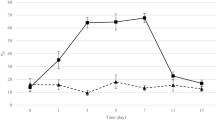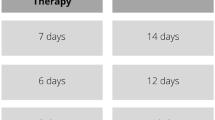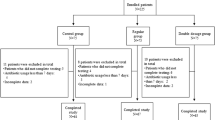Summary
A disturbed microbiological ecosystem of the gut flora is frequently seen as a consequence of antibiotic therapy. Because this impact on the physiological balance is known to be causative for severe nosocomial infections and is mainly seen with antibiotics that are massively excreted via the bile (e.g. broad-spectrum penicillins, ceftriaxone and cefoperazone), we investigated cefotaxime (CTX), cefotiam (CTM), cefmenoxime (CMX), ceftazidime (CAZ), ceftizoxime (CZX) and cefazolin + netilmicin (CEZ + NTL) in healthy volunteers. The respective daily i.v. doses, days of medication and numbers of volunteers were: CTX 3 g, 1 d, n=8; CTM 6 g, 3 d, n=15; CMX 4 g, 3 d, n=15; CAZ 4 g, 1 d, n=8; CZX 4 g, 1 d, n=8; CEZ + NTL 2 × 3 g + 1 × 3 mg/kg/day, 4 d, n=15. CTX was also investigated in 11 selected hospitalized patients. One or two stool specimens were taken before, during and several days after medication. The microorganisms were also tested for ampicillin and CEZ resistance on selective media. Ampicillin and CEZ resistance was much higher in hospitalized patients than in volunteers (mainlyProteus andSerratia sp.): 90% vs. 42% and 63.6% vs. 43%, respectively. CTX did not affect the anaerobes (Bacteroides sp. and lactobacilli) that are antagonistic to clostridia andCandida. No selection of strains resistant to ampicillin or CEZ occurred. In hospitalized patients, the level of resistance to these drugs was lower after treatment than before.
CTM (6–10% biliary excretion) reduced lactobacilli andPseudomonas, andCandida increased. CMX with a higher biliary excretion rate than CTX markedly affected the anaerobes.Candida increased equivalent to the decrease of the gram-positive anaerobe rods (bifidus group and lactobacilli). CAZ reduced lactobacilli andEnterobacteriaceae considerably. Ampicillin and CEZ-resistant strains were more frequent after medication than before, despite low biliary excretion. TwoPseudomonas strains occurred after injection. Due to suppression of lactobacilli, an increase ofCandida is to be expected after multiple injections. CZX did not affect the anaerobes, but more CEZ-resistant strains were present after medication than before. In some cases a greater number ofCitrobacter andProteus was observed. CEZ + NTL massively eradicated both aerobes and anaerobes.Streptococcus faecalis ranged at the first position of the total faecal flora (80%).Candida increased significantly andPseudomonas occurred in several cases.Proteus sp. were selected and were also present on day seven. This might be due to considerable biliary excretion of both drugs. These results emphasize the fact that a high biliary excretion of antibiotics may foster a selection ofEnterobacteriaceae with high MICs, clostridia andCandida by influencing the ecological balance of the gut flora. This should have consequences for prevention of nosocomial infections.
Zusammenfassung
Ein gestörtes mikrobiologisches Ökosystem der Darmflora wird oft als Folge einer Antibiotika-Behandlung gesehen. Da diese Beeinträchtigung des physiologischen Gleichgewichts als Ursache für bedrohliche nosokomiale Infektionen bekannt ist und hauptsächlich durch Antibiotika mit hoher biliärer Ausscheidung (wie zum Beispiel Breitspektrum-Penicilline, Ceftriaxon und Cefoperazon) verursacht wird, untersuchten wir diesbezüglich Cefotaxim (CTX), Cefotiam (CTM), Cefmenoxim (CMX), Ceftazidim (CAZ), Ceftizoxim (CZX) und Cefazolin + Netilmicin (CEZ + NTL) bei gesunden Probanden. Die Tagesdosen (i. v.), Tage und Probandenzahlen waren im einzelnen: CTX 3 g, 1 d, n=8; CTM 6 g, 3 d, n=15; CMX 4 g, 3 d, n=15; CAZ 4 g, 1 d, n=8; CZX 4 g, 1 d, n=8; CEZ + NTL 2 × 3 g + 1 × 3 mg/kg und Tag, 4 d, n=15. CTX wurde außerdem an elf ausgewählten hospitalisierten Patienten geprüft. Ein bis zwei Stuhlproben wurden entnommen vor, während und einige Tage nach der Medikation. Die Bakterien wurden außerdem auf Ampicillin- und Cefazolin-Resistenz untersucht. Ampicillin- und Cefazolin-Resistenz war viel häufiger bei hospitalisierten Patienten als bei Probanden (meistensProteus undSerratia sp.): 90% gegenüber 42% und 63,6% gegenüber 43%. CTX beeinträchtigte nicht die Anaerobier (Bacteroides sp. und Laktobakterien), die ein Gegengewicht zu Clostridien undCandida darstellen. Selektion von Ampicillinoder Cefazolin-resistenten Stämmen kam nicht vor. Bei hospitalisierten Patienten war Resistenz gegen diese Antibiotika nach der Behandlung seltener als vorher. CTM (6–10% biliäre Ausscheidung) verminderte Laktobakterien; Pseudomonas undCandida nahmen zu. CMX, das eine höhere Galleausscheidung als CTX hat, beeinträchtigte ausgeprägt die Anaerobier,Candida nahm zu entsprechend der Abnahme der grampositiven aeroben Stäbchen (Bifidus-Gruppe und Laktobakterien). CAZ verminderte beträchtlich Laktobakterien und Enterobacteriaceae. Nach der Medikation fanden sich mehr Ampicillin- und Cefazolin-resistente Stämme als vorher trotz niedriger Gallenausscheidung. ZweiPseudomonas sp. wurden nach der Injektion isoliert. Durch die Unterdrückung von Laktobakterien ist nach wiederholter Gabe mit einer Zunahme vonCandida zu rechnen. CZX unterdrückte nicht die Anaerobier, aber nach der Medikation fanden sich mehr CEZ-resistente Stämme als vorher. In einigen Fällen wurden vermehrt Citrobacter und Proteus gesehen. CEZ + NTL verminderte massiv sowohl Aerobier als auch Anaerobier.Streptococcus faecalis nahm mit 80% die erste Stelle in der gesamten Darmflora ein.Candida nahm signifikant zu, und Pseudomonas kam in einigen Fällen vor.Proteus wurde selektiert und war noch am siebten Tag nachzuweisen. Dies ist wahrscheinlich auf die erhebliche Gallengängigkeit der Kombination zurückzuführen. Diese Ergebnisse führen zu dem Schluß, daß eine hohe Gallenexkretion von Antibiotika eine Selektion von Enterobacteriaceae mit hohen MHKs von Clostridien undCandida begünstigt, indem das ökologische Gleichgewicht der Darmflora gestört wird. Daraus sollten Konsequenzen zur Vermeidung von nosokomialen Infektionen gezogen werden.
Similar content being viewed by others
Literature
Alestig, K. Effect of cefoperazone on the faecal flora. J. Antimicrob. Chemother. 12 (1983) 163–167.
Lambert-Zechovsky, N. Antibiotic therapy and microbial ecology. Rev. Med. 21 (1980) 1363–1369.
Siemens, H. J. Plasmids in intestinalEscherichia coli isolates and the influence of ampicillin. Infection 9 (1981) 131–136.
Stahlmann, R., Lode, H. Neue Penicilline: antibakterielle, pharmakokinetische und therapeutische Eigenschaften. Klinikarzt 12 (1983) 694–713.
Kager, L. The effect of piperacillin prophylaxis on the colonic microflora in patients undergoing colorectal surgery. Infection 11 (1983) 251–254.
Arvidsson, A. Ceftriaxone: renal and biliary excretion and effect on the colon microflora. J. Antimicrob. Chemother. 10 (1982) 207–215.
Mulligan, M. E. Impact of cefoperazone therapy on faecal flora. Antimicrob. Agents Chemother. 22 (1982) 226–230.
Guggenbichler, J. P., Kofler, J. Influence of third-generation cephalosporins on aerobic intestinal flora. J. Antimicrob. Chemother. 14 Suppl. B (1984) 67–70.
Author information
Authors and Affiliations
Rights and permissions
About this article
Cite this article
Knothe, H., Dette, G.A. & Shah, P.M. Impact of injectable cephalosporins on the gastrointestinal microflora: Observations in healthy volunteers and hospitalized patients. Infection 13 (Suppl 1), S129–S133 (1985). https://doi.org/10.1007/BF01644233
Issue Date:
DOI: https://doi.org/10.1007/BF01644233




